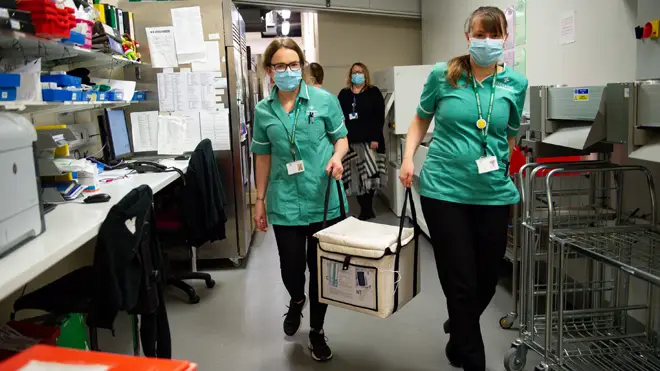
Paul Brand 3pm - 6pm
8 April 2021, 00:58 | Updated: 8 April 2021, 17:56

The prevalence of Covid-19 cases in England fell by around 60 per cent from February to March, a recent study has suggested.
Infection rates dropped in all age groups and regions across both months but recent data indicates the decline is "levelling off", researchers said.
Figures also suggest that the rollout of the coronavirus vaccines could be "breaking the link" between cases, deaths and hospital admissions.
The latest round of the Real-Time Assessment of Community Transmission (React-1) study found that, on average, one in 500 people was still infected with Covid-19 in March.
Researchers said there had been "big falls" in the prevalence of the virus in the South East and London from February to March.
However, they added that there are still "persistent areas of higher prevalence" of the virus in the southern part of Yorkshire, and parts of the East Midlands and the North West.
Read more: First Moderna dose given in UK as carer Elle Taylor gets vaccine
Read more: Under-30s to be offered alternative to Oxford-AstraZeneca jab

Jeremy Hunt tells LBC the Oxford/AstraZeneca vaccine remains safe
So far, more than 1.5 million people have provided swabs to the React-1 study, which have allowed experts to study infection rates across the nation.
The tenth round of tests were carried out between 11 and 30 March, during which 140,844 swabs were collected and of those 227 provided positive results.
This is compared with 689 positive results out of 165,456 swabs collected between 4 and 23 February.
Health Secretary Matt Hancock said: "These findings are promising and illustrate the significant impact that lockdown, combined with our phenomenal vaccination programme, is having on the prevalence of this dreadful virus.
"We are meeting our four tests for easing the lockdown and there are many reasons to be optimistic for the future, but we cannot let this come at the expense of vigilance today.
"The only way to safeguard the progress we have made as a country is by continuing to show caution and by doing everything we can to drive this virus into retreat - practising hands, face, space and meeting outdoors, and accepting the offer of a vaccine when it comes."
Read more: Rare AZ vaccine blood clot 'side effect' will not stop roadmap, PM says
Explained: What are the rare blood clots linked to AZ jab and what are the symptoms?

PM does not believe jab 'course correction' will affect roadmap
The researchers' findings, due to be released as a pre-print, were outlined in a briefing to journalists on Wednesday and included:

Under-30s to be offered alternative to Oxford/AstraZeneca jab
Steven Riley, professor of infectious disease dynamics at Imperial College London, said: "The good news is prevalence has decreased by approximately 60% from the previous round in February to the current results now in March.
"The most recent data doesn't show a continued obvious decline, we have a levelling off of prevalence, and that's reflected in an R estimate of 1.
"And we see some divergence between our observed patterns of infection and patterns of death since January, which we think probably suggests that the mass vaccination is breaking that link to some degree between infections and deaths."
Commenting on infection, deaths and hospital admissions data, he said: "We're observing fewer deaths per infection than we would have expected based on the recent prior months of the study."
He added: "To a lesser extent, we're seeing fewer hospitalisations per infection as well.
"We think that this is a signal of how the vaccination programme is breaking the link, the previously strong link, between the pattern of infections and the patterns of deaths and hospitalisations."

The benefits of the AstraZeneca vaccine outweigh the risks
Prof Riley warned that if the vaccine rollout slowed down, then researchers would expect to see higher levels of infection.
Professor Paul Elliott, director of the programme at Imperial from the School of Public Health, said: "I think we're beginning to see in our data the effect of the vaccine, certainly in severe outcomes."
He added that more work was needed to look at the impact of the vaccine on prevalence and transmission.
Prof Elliott acknowledged that the "big decline" in the rate of infection had "flattened off" in March but said it was "good news" that it did not rise with the recent relaxation of restrictions, such as more permitted social mixing and the return of pupils to schools.
He said a "close watching brief" was needed as lockdown is eased further, with a "careful balancing act" needed.